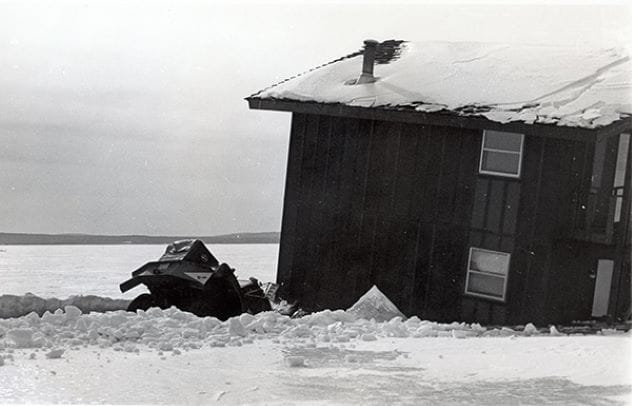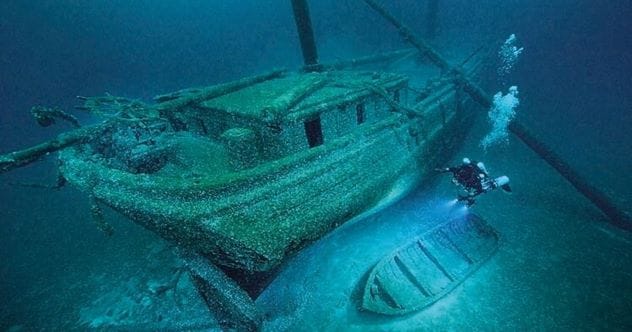The Great Lakes, sprawling across 95,000 square miles and holding 6 quadrillion gallons of water, comprise the largest freshwater system on Earth. These waters hide more than 170 fish species and a history of over 6,000 shipwrecks. But the bottom of these lakes is also home to some truly bizarre artifacts.
Let’s dive into ten of the weirdest things discovered at the bottom of the Great Lakes!
A 1910 Locomotive Steam Engine
In June 1910, a rockslide threw Canadian Pacific Railroad locomotive 694 off its tracks near Marathon, Ontario. The engine, along with several boxcars, plunged into Lake Superior, settling 60 feet below the surface. Three crewmen died in the accident.
The wreckage remained untouched for 106 years until it was found in 2016 by shipwreck hunters. It’s the only known locomotive wreck in the Great Lakes.
The Largest Unmodified Collection of Nash Automobiles
Ever wonder where you might find a pristine collection of vintage cars? Try the bottom of Lake Michigan! These cars are “unmodified” because they’re almost 500 feet underwater!
On October 31, 1929, the SS Senator, carrying 268 Nash automobiles worth over $3.8 million today, sank after colliding with another ship in dense fog. The wreck was discovered in 2005, revealing perfectly preserved vehicles. The site was added to the National Register of Historic Places in 2016.
Michigan’s Very Own Stonehenge
While searching for shipwrecks in 2007, archaeologists found a circle of stones 40 feet deep in Lake Michigan. This “miniature Stonehenge” might have been built by Indigenous people during the last Ice Age when the lakebed was dry. One rock even features a possible mastodon carving, potentially dating the formation back thousands of years.
The purpose of the rocks remains a mystery, but a similar formation on nearby Beaver Island suggests it’s no accident.
An Ancient Hunting Camp
In Lake Huron, at a depth of 120 feet along the Alpena-Amberley Ridge, lies an ancient hunting camp. Around 9,000 years ago, when lake levels were much lower, this ridge would have been ideal for hunting migrating caribou. Hunters could trap the animals between water on both sides.
Scientists discovered parallel lines of stones and V-shaped stone formations, likely used as hunting blinds. Artifacts used for tool repair were also found, providing insights into early hunting practices.
Rare World War II Fighter Planes
The Douglas Dauntless was a formidable World War II fighter plane. Today, only 14 are known to exist, but about 75 of them sit on the bottom of Lake Michigan.
During the war, the U.S. Navy used Lake Michigan to train carrier pilots, launching planes from the USS Wolverine. The training program was highly successful, but accidents happened, resulting in numerous aircraft losses. Recover efforts started in 2004. Several of those existing planes today are from Lake Michigan.
A World War I German U-Boat
In 1921, the USS Wilmette sank a German UC-97 submarine in Lake Michigan. Why was a German U-Boat in an American lake?
After World War I, the Allies seized German submarines, allowing nations to study them. The U.S. took six boats and toured them across the country to raise funds for war debt. The UC-97 was later used for target practice and sunk in Lake Michigan as required in the Treaty of Versailles. The wreckage was rediscovered in 1992.
An 11-Foot Marble Crucifix
Off the shore of Petoskey, Michigan, rests an 11-foot marble crucifix. Commissioned as a grave marker in the 1950s, the statue was damaged during shipping and rejected by the couple who ordered it.
The Wyandotte Diving Club purchased it as a memorial to a fellow diver. Divers can visit it, and in winter, when conditions allow, people can view it through a hole in the ice.
Old Whitey, the Preserved Corpse of the USS Kamloops
The cold, sterile waters of the Great Lakes preserve sunken items remarkably well, including the bodies of sailors. When the USS Kamloops sank in Lake Superior in 1927, it remained lost for 50 years.
Upon rediscovery, the ship was found to be incredibly well-preserved. Divers even found the body of a crewmember in the engine room, nicknamed “Whitey” due to the waxy appearance caused by the cold temperatures. Many wrecks are controlled diving sites to respect the final resting places of those lost.
A Seven-Room, Fully Furnished Vacation House

In 1977, someone tried to move a seven-room house across the frozen Lake Superior between Bayside, Wisconsin, and Madeline Island. Lyle Rhine, a mover from Minneapolis, plowed an ice road for the purpose.
The move went smoothly for three miles until the trailer broke through the ice. Lyle and his partner escaped as the truck and the house sunk into 70 feet of water. Efforts to salvage the house failed, and it broke apart, remaining on the lake floor.
Canadian Model Airplanes
These aren’t just any model airplanes. These 1/8-scale models were for the Avro Arrow, a cutting-edge aircraft built by Avro Canada for the Royal Canadian Air Force in the 1950s. The models tested the “delta wing” design over Lake Ontario.
The Canadian Prime Minister abruptly canceled the Avro Arrow project in 1959, and the completed planes were scrapped. To prevent replication, the models used for testing were dumped in the lake. Four of the nine models have since been recovered and are being restored by the Canadian Conservation Institute.
The Great Lakes hold many secrets, some fascinating and others downright strange. Which find surprised you the most? Leave your comment below!










